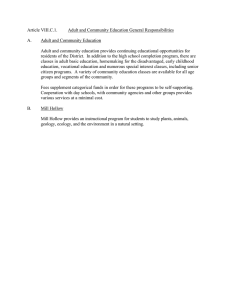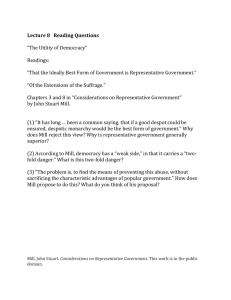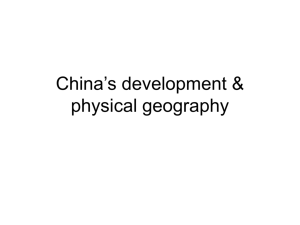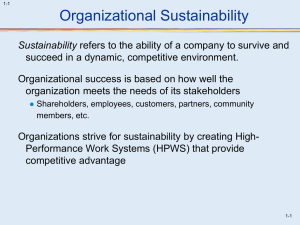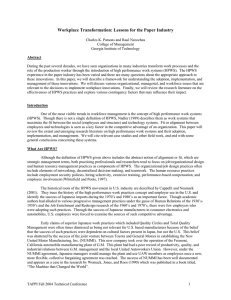High Performance Work Systems in the Paper Industry
advertisement
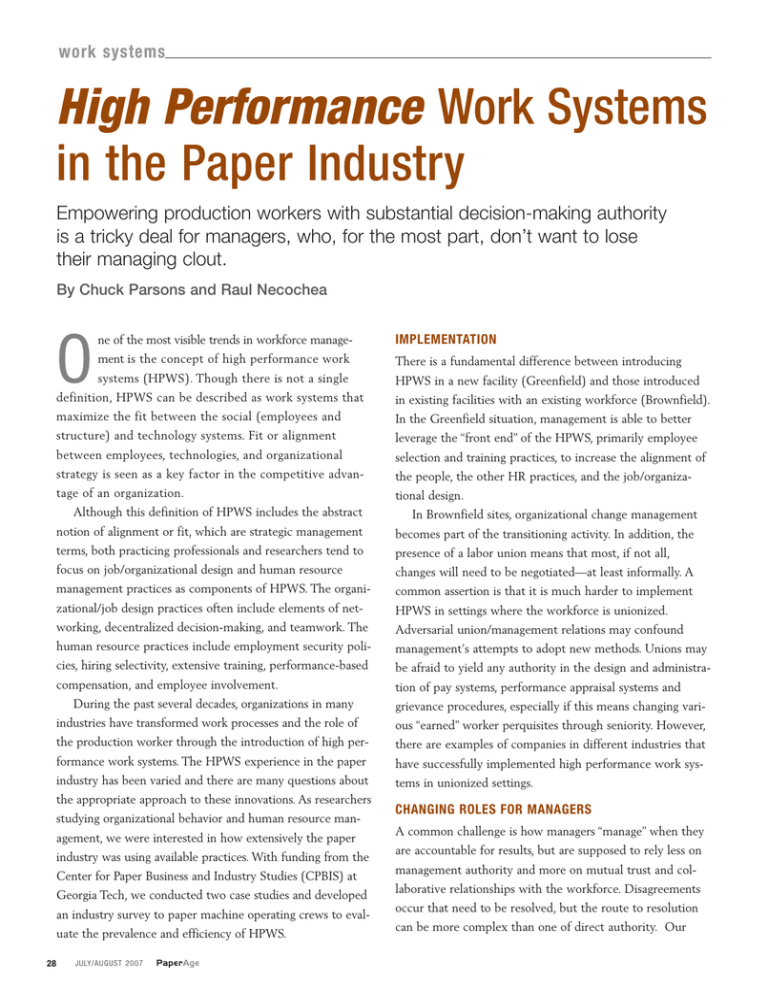
work systems High Performance Work Systems in the Paper Industry Empowering production workers with substantial decision-making authority is a tricky deal for managers, who, for the most part, don’t want to lose their managing clout. By Chuck Parsons and Raul Necochea O ne of the most visible trends in workforce manage- IMPLEMENTATION ment is the concept of high performance work There is a fundamental difference between introducing systems (HPWS). Though there is not a single HPWS in a new facility (Greenfield) and those introduced definition, HPWS can be described as work systems that in existing facilities with an existing workforce (Brownfield). maximize the fit between the social (employees and In the Greenfield situation, management is able to better structure) and technology systems. Fit or alignment leverage the “front end” of the HPWS, primarily employee between employees, technologies, and organizational selection and training practices, to increase the alignment of strategy is seen as a key factor in the competitive advan- the people, the other HR practices, and the job/organiza- tage of an organization. tional design. Although this definition of HPWS includes the abstract In Brownfield sites, organizational change management notion of alignment or fit, which are strategic management becomes part of the transitioning activity. In addition, the terms, both practicing professionals and researchers tend to presence of a labor union means that most, if not all, focus on job/organizational design and human resource changes will need to be negotiated—at least informally. A management practices as components of HPWS. The organi- common assertion is that it is much harder to implement zational/job design practices often include elements of net- HPWS in settings where the workforce is unionized. working, decentralized decision-making, and teamwork. The Adversarial union/management relations may confound human resource practices include employment security poli- management’s attempts to adopt new methods. Unions may cies, hiring selectivity, extensive training, performance-based be afraid to yield any authority in the design and administra- compensation, and employee involvement. tion of pay systems, performance appraisal systems and During the past several decades, organizations in many ous “earned” worker perquisites through seniority. However, the production worker through the introduction of high per- there are examples of companies in different industries that formance work systems. The HPWS experience in the paper have successfully implemented high performance work sys- industry has been varied and there are many questions about tems in unionized settings. the appropriate approach to these innovations. As researchers studying organizational behavior and human resource management, we were interested in how extensively the paper industry was using available practices. With funding from the Center for Paper Business and Industry Studies (CPBIS) at Georgia Tech, we conducted two case studies and developed an industry survey to paper machine operating crews to evaluate the prevalence and efficiency of HPWS. 28 grievance procedures, especially if this means changing vari- industries have transformed work processes and the role of J U LY / A U G U S T 2 0 0 7 PaperAge CHANGING ROLES FOR MANAGERS A common challenge is how managers “manage” when they are accountable for results, but are supposed to rely less on management authority and more on mutual trust and collaborative relationships with the workforce. Disagreements occur that need to be resolved, but the route to resolution can be more complex than one of direct authority. Our work systems observations here come from some field work we have done managing the mill appropriately. Workers developing a in the paper industry. sense of ownership over their companies, ironically, is a goal Case 1 - Forums Replace Unilateral Management Decisions of HPWS. But in this case the manager saw that as counterproductive. The first case takes place in a recycled containerboard mill When it was suggested that the mill’s production was in the Midwest United States. Three years after opening, thriving despite his assessment of the workforce, he retorted the status of the technicians changed to the salaried nonex- that the positive results probably had more to do with empt category, which meant that they could have both the modern technology and better training, and not the team benefits of salaried employees and still earn overtime pay. In structure. No doubt the perception that “workers had too the transition to salaried status, the technicians also lost much power,” as one manager nakedly admitted, also played some vacation time, but gained better retirement benefits. a role in the subsequent events. A production manager’s From the start, the technicians have been organized as self-managing work teams, each working 12-hour shifts. One apparent inflexibility became the lighting rod for worker anger, especially after he pointed out, with some accuracy, manager acknowledged that this that some “untouchable” cliques is a highly trained work force had formed around the oldest that engages in cross-functional technicians who had been there problem solving. For example, if from the beginning of the mill’s there is a problem with a operations. Management’s solution was machine, the teams have authority to take it down for repairs. to shuffle the composition of They also have the authority to teams to deal with the untouch- make a machine run faster, hav- ables. Workers expressed their ing only a minimum speed limit strong dislike for the idea and at which a machine can run for even threatened to call a union each grade in order to meet the representative. As a Human budgetary expectations of man- Resources officer at the company agers. Most managers recognized that running a mill with such an During the past several decades, said, “We definitely don’t want a union here.” Ironically, one of empowered workforce generated organizations in many industries greater worker expectations for have transformed work processes formation of yet another worker/ and the role of the production worker management committee, which the performance of managers. With the amount of power concentrated on the teams, especially on the most experi- through the introduction of high performance work systems. the consequences has been the attempts to air out sources of conflict between workers and management before they become dramatically divisive enced and skilled workers, management proposed some changes to the team structure issues. One of the technicians, a member of the committee, that would curb some tendencies managers disapproved sarcastically calls their meetings the UA meetings, or Union of, like shift-swapping between workers of different teams Avoidance meetings. and the scheduling of too much overtime for some workers Thus in this mill, conflict occurred between management by the teams themselves. In the view of one manager, some and workers over an issue that was strictly a management of the more senior technicians had begun to put their per- prerogative in a traditional mill. Under HPWS, the resolu- sonal and team welfare ahead of the mill’s welfare. He sug- tion could not be a unilateral management decision (as was gested that the technicians had come to believe they attempted), but rather the creation of another forum for “owned” the mill and that this was counterproductive to worker involvement. PaperAge J U LY / A U G U S T 2 0 0 7 29 work systems Case 2 - Programs Limit Management Authority did not pass a medical exam for drug use. The union was The second case takes place in another mill, this time in the allowed back in, a gain-sharing program was instituted, and a southeast U.S. The mill had been sold from one paper degree of self-directedness was encouraged for workers, all company to another. Up to that point the workforce had within the limits imposed by the continuous improvement pro- been unionized. The initial changes were traumatic. gram. In fact, the pendulum has swung back too far for some Workers lost approximately 30% of their retirement funds production managers. One acknowledged he was not as fond in the buyout. Moreover, the new management was com- of the liberties of the mill workers, saying they made it very mitted to a continuous improvement program based on hard for supervisors to discipline them, and also that some Total Quality Management principles. The firm decided to workers abuse the liberties they had. This manager credited impose the new program on the old workforce and let all the monetary incentives like gain-sharing with the successful workers go as soon as the acquisition was complete, promising cooperative culture found within the mill, “everybody stands to reinstate them if they agreed to “get with the program.” to gain by acting that way [cooperatively].” As one worker sarcastically commented, the acquiring firm In this case, as in the first one, some managers continue to was flexible: if a worker found the arrangement unaccept- struggle with their lack of authority. The limited level of able, he was welcome to leave. employee self-direction here might be part of the problem in Yet, even this worker, one of the most senior we encoun- that the employees are not managing each other. Ultimately, tered, admits the firm’s stance softened considerably after a as in the first case, the problems may need to be resolved while. For starters, almost all workers got their jobs back—albeit through joint consultation. after signing on with the firm’s continuous improvement program. The only ones who did not come back were those who Both cases point out the different role and expectations of managers in a HPWS setting. It is often stated that the Ta b l e 1 . H u m a n R e s o u r c e s P r a c t i c e s 30 PRACTICE DEFINITION Self-directed Work Team Also termed autonomous work groups, semi-autonomous work groups, self-regulating work teams or simply teams. The work group (in some cases operating without a supervisor) is responsible for a whole product or service and makes decisions about task assignments and work methods. The team may be responsible for services such as maintenance, purchasing, quality control, and hiring. Employee ProblemSolving Groups (Including Quality Circles) Structured employee participation groups in which individuals from a particular work area meet regularly to identify and suggest improvements to work-related problems. The goals of these groups are improved quality and productivity; there are no direct rewards for group activity; group problem solving training is provided; and the group’s only power is to suggest changes to management. Job Rotation A planned rotation of workers among different jobs. Total Quality Management Programs Programs that focus on providing customers with error-free products or services through a process of continuous improvement. Gain Sharing Gain sharing plans are based on a formula that shares some portion of gains in productivity, quality, cost-effectiveness, or other performance indicators. The gains are shared in the form of bonuses with all employees in an organization (such as a mill). They typically use employee suggestion committees and they differ from profitsharing and ESOPs in the basis of the formula is some set of local performance measures, not company profits. Examples include Scanlon plan, the Improshare Plan, the Rucker Plan, and various custom-designed plans. Employment Security Policy Corporate or Mill Policy designed to prevent layoffs of permanent employees. Pay for Skill Program An alternative to traditional job-based pay that sets pay levels based on how many skills employees have or how many jobs they potentially can do, not on the job they are currently holding. Also called pay for skills, pay for knowledge, and competency-based pay. Profit-Sharing/Bonus Program A bonus plan that shares some portion of mill or corporation profits with employees. It does not include dividend sharing. Removal of Shift Supervisors/Delayering Elimination of a level of management (including shift supervisor) J U LY / A U G U S T 2 0 0 7 PaperAge work systems Ta b l e 2 . Prevalence of Practices in Industry Percent Used Year Began (% before 1996) Percent Still Used Effectiveness (1 - Not at all, 5 - A great deal) Self Directed Work Teams 33% 45% 75% 3.9 Employee Problem-Solving Groups 46% 67% 61% 4.0 Job Rotation 39% 67% 100% 4.0 TQM/CQI 54% 89% 77% 3.7 Gain Sharing 37% 44% 77% 3.1 Employment Security Policy 11% 0% 100% 3.0 Pay for Skills Program 23% 67% 78% 2.3 Profit-Sharing/Bonus Program 40% 27% 92% 3.1 Removal of Shift Supervisors/Delayering 29% 36% 91% 3.6 Practice training needs are high for workers in such settings, but the practices). This may be due to the nature of the specific same would appear to hold true for managers; especially goals of these teams, but there are undoubtedly problems those who have worked in a more traditional setting. encountered daily that could be tackled using this practice. INDUSTRY SURVEY One final result from this survey is to note the number of adoptions prior to 1996 as opposed to 1996 and beyond. To investigate how widespread and effective various human From this survey, there are 99 incidents of practice adoption resource practices are in the paper industry, we developed a and 60 of these occurred prior to 1996. At the time of this survey to measure the adoption and use of nine human data collection (2004), this indicates that the majority of resource practices (see Table 1). For each of these practices, practices were adopted prior to 1996. This rate of practice survey recipients were asked if the practice was ever used, in adoption is about in line with other industries. what year adopted, was the practice still in effect, when was it discontinued (if not in use), what percentage of the work- CONCLUSION force was involved, and the overall effectiveness of the prac- As we have suggested, the practice of HPWS is not as wide- tice. We used a random approach to represent different mills spread as the evidence on its effectiveness might dictate. types of varying product lines and union presence. Surveys There are significant management challenges both within were sent to paper machine operating crews representing and between companies in the same industry. However, this 107 mills. We received completed surveys from crews repre- situation also provides opportunity to those companies who senting a total of 31 mills. can become better than the competition at the adoption, Table 2 lists the results from this survey. The most widely implementation, and management of these systems. used practices as indicated from survey responses were Numerous examples abound of companies that have TQM/CQI (54%) and Employee Problem-Solving Groups prospered for years in very competitive industries, in part (46%). In analyzing the survey results on adoption of these because of their successful embrace of high performance nine practices and their effectiveness, the year 1996 was work systems. ■ chosen as a reference year. At the time of data collection (2004), this provided sufficient time for the effectiveness of these practices to be evaluated. The two most effective processes were Employee Problem-Solving Groups and Job Rotation. It is interesting to note that while Employee Problem-Solving Groups are noted to be quite effective, they are not practiced very often (only 61% still have them in effect—the lowest of all Dr. Charles Parsons is a professor at Georgia Tech’s school of management. He is looking for opportunities to study HPWS in mills, its relationship to productivity, the dynamics of HPWS introduction, and dynamics of union-management relationships and adoption/implementation. Chuck can be reached at: charles.parsons@mgt.gatech.edu or directly at 404-894-4921. Raul Necochea is a doctoral candidate in the History department at McGill University. His research interests include the history of technology and the history of American labor. He can be reached at raul.necochea@mail.mcgill.ca. PaperAge J U LY / A U G U S T 2 0 0 7 31

